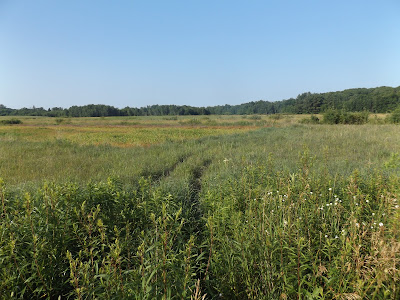 |
| Jeep trail leading into Cylon State Wildlife Area. |
 |
| Cylon State Wildlife Area map |
The wildlife area in St. Croix County offers a rare mix of plants found in both southern and northern Wisconsin. The woods and sedge meadows sit in what biologists call a “tension zone.”
To reach the wildlife area, from the village of Deer Park head north on Wis. Hwy. 46. Turn right/east onto County Road H. Between 240th and 250th streets, look for a gravel parking lot on the road’s right/south side.
Only primitive trails run through the wildlife area, and there are no clearly marked routes. An old jeep trail does head roughly southwest from the lot’s south side through a grasslands, though.
Much of the sedge meadow sits around the North Fork of the Willow River, eight miles of which flow through the wildlife area, and the streams feeding the Willow. Among the dominant plants are broad-leaved white meadowsweet, steeplebush and wire-leaved sedges. Birds often nest in the sedge meadows or near its edges; among those you’re likely to spot are the ovenbird, the red-eyed vire, the broad-winged hawk in the air, and ruffed grouse on the ground.
The jeep trail and the edge of an intermittent stream can be followed about 1100 feet one way to a hardwood forest.
More than half of the wildlife area is hardwoods forest. A variety of oaks can be found there, including bur, Hill’s and white, mixed with basswood, and white pine. American elm and red maple dominate the sapling layer. Ironwood is prevalent in the sub-canopy layer with blackberry and hazelnut common shrubs. A variety of ground flora can be spotted here as well, including black snakeroot, enchanter's nightshade, sweet cicely, tick-trefoil, large-flowered trillium, maidenhair fern, wild strawberry, Canada mayflower, and partridgeberry.
The tension zone largely is determined by climate. Temperatures in the wildlife area are just high enough to support the southern plant species but not so hot that the northern species won’t prosper.
As with other wildlife areas, there no facilities. In early summer, the trails become quickly overgrown, so if hiking much past May you will need to don long pants and a long-sleeved shirt.
•Road map of wildlife area
•Topo map of wildlife area
Learn more about nearby day hiking trails in my Day Hiking Trails of St. Croix County guidebook.
